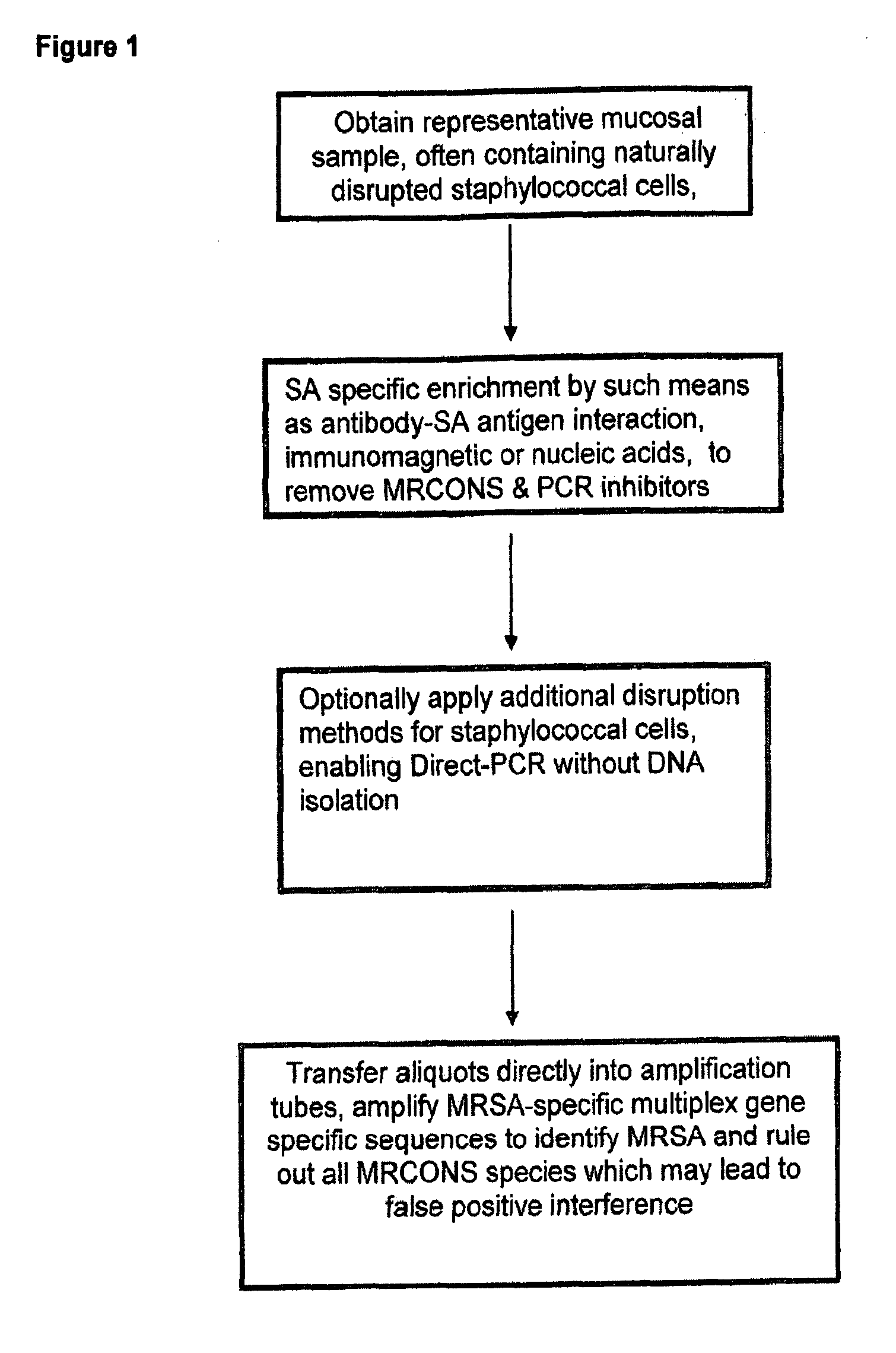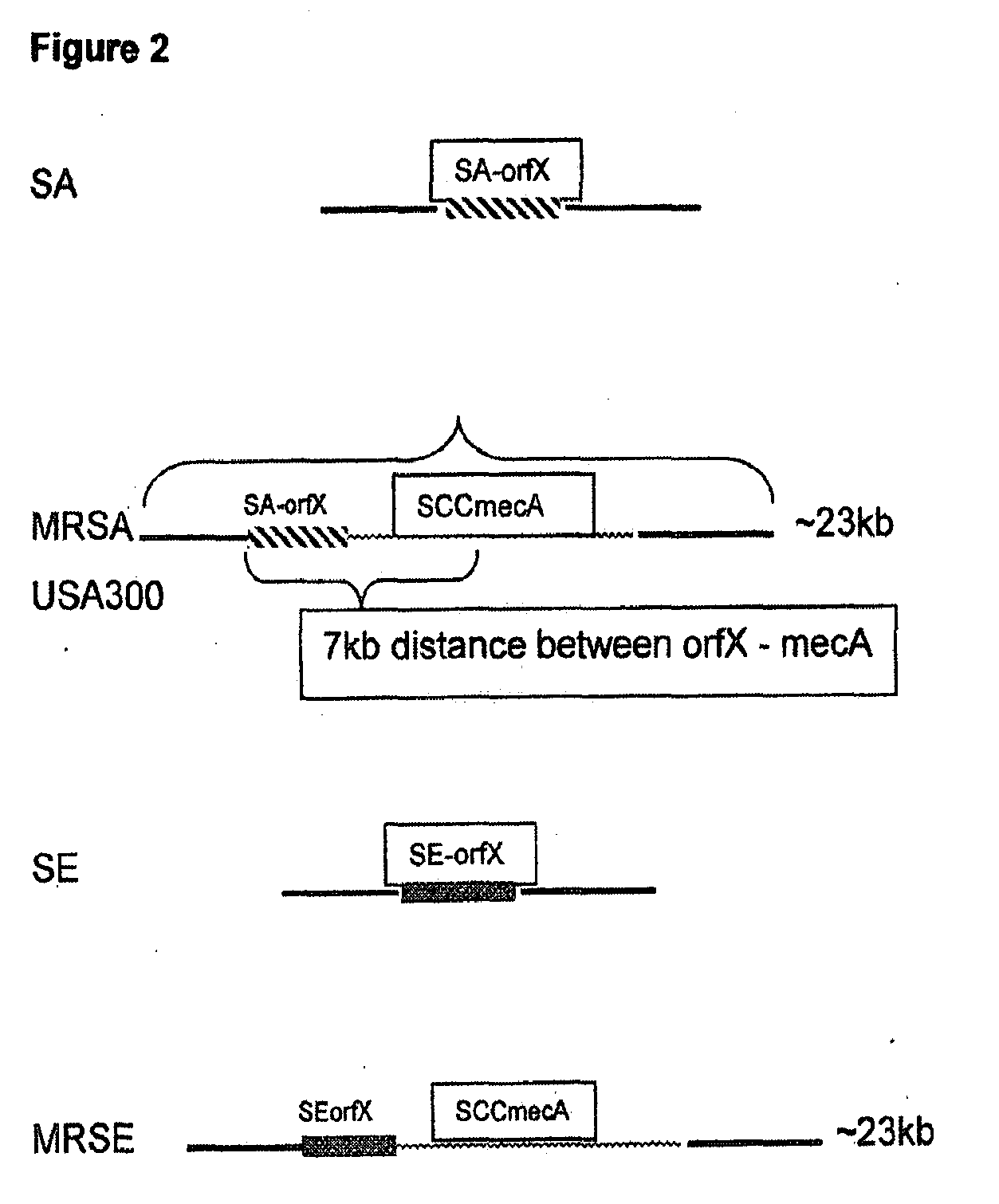Methods and Compositions Including Diagnostic Kits For The Detection In Samples Of Methicillin-Resistant Staphylococcus Aureus
a technology of methicillin-resistant staphylococcus aureus and diagnostic kits, which is applied in combinational chemistry, biochemistry apparatus and processes, library screening, etc., can solve the problems of high medical care cost, poor clinical outcomes, and soft tissue and bloodstream infections that may become rapidly fatal to infected individuals
- Summary
- Abstract
- Description
- Claims
- Application Information
AI Technical Summary
Benefits of technology
Problems solved by technology
Method used
Image
Examples
example 1
Achromopeptidase Disruption of the SA Cell Wall, Compatible with Direct-PCR & Nasal Swab Samples Containing PCR Inhibitors
[0040]Nasal samples were obtained from nasal swabs after elution with 200 micro liters of TE. Samples were then incubated with or without achromopeptidase (ACP) incubation at 1 Unit / ul 37 C for 15 minutes followed by 99 C for 5 minutes. Direct TaqMan PCR amplification of an exogenous spiked in control template DNA at a volume of up to 2.5 micro liters of this ACP lysate in a 25 micro liter PCR reaction, confirmed compatibility. Further, transfer of volumes greater than 2.5 ul in to the 25 ul PCR showed inhibition from both sample types, suggesting that inhibition might start to negatively effect PCR above this volume proportion if not removed. Thus, it has been shown that in accordance with the present invention, ACP Direct PCR from nasal swab samples can be improved by removal of PCR inhibitors using methods such as cell, or DNA enrichment, activated charcoal et...
example 2
ACP Followed by Qiagen Silica DNA Isolation
[0041]When the above-described ACP disruption system was performed on TE buffer spiked with varying CFU numbers of SA strain ATCC-29213, and then followed by Qiagen Micro kit DNA isolation, the reproducible lower limit measured by TaqMan nuc137 real-time PCR was less than or equal to 10 colony forming units (CFU). These sample amplification results are consistent with and suggest that the vast majority of SA cells are also disrupted due to ACP treatment.
example 3
Prevalence of Nasal SA by Culture and PCR
[0042]In a preliminary study using routine SA culture methods, 15 random subjects were tested for nasal swab SA and 4 subjects were shown to be positive by Culture resulting in a prevalence of SA at 27%. This same n=15 sample set was also disrupted by ACP (1 u / ul), after being eluted in TE (10 mM, 1 mM EDTA), by vortexing the nasal swab for 1 minute. DNA was then isolated using the commercially available Qiagen Micro kit and SA specific TaqMan nuc137 real-time PCR showed 100% concordance with the culture results. Process blanks and controls indicated that no contamination was present during this study. This SA prevalence number is in agreement with the expected percentage found in the literature.
PUM
| Property | Measurement | Unit |
|---|---|---|
| volume proportion | aaaaa | aaaaa |
| volume proportion | aaaaa | aaaaa |
| acid | aaaaa | aaaaa |
Abstract
Description
Claims
Application Information
 Login to View More
Login to View More - R&D
- Intellectual Property
- Life Sciences
- Materials
- Tech Scout
- Unparalleled Data Quality
- Higher Quality Content
- 60% Fewer Hallucinations
Browse by: Latest US Patents, China's latest patents, Technical Efficacy Thesaurus, Application Domain, Technology Topic, Popular Technical Reports.
© 2025 PatSnap. All rights reserved.Legal|Privacy policy|Modern Slavery Act Transparency Statement|Sitemap|About US| Contact US: help@patsnap.com


